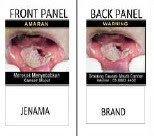MENGENALI ROKOK YANG SAH DAN YANG
TIDAK SAH (Genuinely Imported/Locally manufactured with taxes paid vs
Contraband cigarettes)
. 1. Yang
dimaksudkan “Sah” atau “Tidak Sah” ialah sama ada diluluskan untuk dijual di
pasaran Malaysia. Rokok yang “Sah” adalah rokok sama ada diimport atau dikilang
tempatan yang telah berbayar duti import (jika diimport), duti eksais (untuk
rokok dikilang tempatan atau diimport) dan Cukai Barangan dan Perkhidmatan
(“GST”) (untuk rokok yang diimport atau dikilang tempatan)
2 2. Rokok
yang dikilang tempatan ertinya dikeluarkan oleh kilang Eksais dan rokok yang
diimport perlu mematuhi beberapa syarat sebelum dibenarkan untuk edaran di
pasaran tempatan. Syarat-syarat ini ditetapkan pada lesen Eksais yang
dikeluarkan oleh Jabatan Kastam atau dalam Perintah Kastam (Larangan Mengenai
Import) 2017.
3 3. Berikut
adalah syarat yang ditetapkan dalam Perintah Kastam (Larangan Mengenai Import)
2017:
A. All importers shall comply with the health warning on
cigarette packaging:
(1) Packet of cigarette:
(a) On each packet of cigarette there shall be printed a health
warning consisting of any one of the following set texts and images:
(b) the set texts and images shall be printed with fifty
percent coverage area to be positioned from the top on the front panel and with sixty percent coverage area to be positioned from the
top on the back panel
(c) the images shall be printed with resolution not less than
300 dpi (“dpi” or “dot per inch” means the degree of resolution of printing
images expressed in terms of number of printed dots per linear inch)
(d) the set texts and images shall be printed using not less
than four colour printing
(e) the set texts shall be printed, in lettering of Arial of 10
points for each packet, in pure white on a
Matt Black background, except the
words “AMARAN and “WARNING” which shall be printed, in bold-faced
lettering of
Arial of 12 points for each packet, in yellow on a Matt Black background
HEALTH WARNING 1
HEALTH WARNING 2
HEALTH WARNING 3
HEALTH WARNING 4
HEALTH WARNING 5
HEALTH WARNING 6
HEALTH WARNING 7
HEALTH WARNING 8
HEALTH WARNING 9
HEALTH WARNING 10
HEALTH WARNING 11
HEALTH WARNING 12
HEALTH WARNING 3
HEALTH WARNING 4
HEALTH WARNING 5
HEALTH WARNING 6
HEALTH WARNING 7
HEALTH WARNING 8
HEALTH WARNING 9
HEALTH WARNING 10
HEALTH WARNING 11
HEALTH WARNING 12
4. Syarat-syarat yang sama ditetapkan untuk dipamerkan pada karton iaitu
bungkusan yang
mengandongi peket-peket rokok
(2) Carton of cigarette:
(a) on each carton of cigarette there shall be printed a health
warning consisting of any one of the following set texts and images:
(Imej-imej sama seperti di
atas)
B. Health information on cigarette packaging:
(1) Packet of cigarette:
(a) on each packet of cigarette there shall be printed the
following health information, sale restriction and particulars on its panel:
(b) Cartoon of cigarette:
(a) on each packet of cigarette there shall be printed the
following health information, sale restriction and particulars on its panel:
(b) the health information shall be printed in lettering of
Arial not less than 26 points for each packet.
C. Tax stamp:
(a) on each packet of cigarette there shall be affixed a tax
stamp as approved by the Director General.
(b) the tax stamp
shall not visually obstruct the health warning and health information
5 5. Syarat-syarat
seperti di atas telah ujud sejak 2008 iaitu seperti ditetapkan dalam Perintah
Kastam (Larangan Mengenai Import) 2008 yang telah berkuatkuasa pada 1 Apr 2008
sehingga digantikan dengan Perintah Kastam (Larangan Mengenai Import) 2012 pada
April 2013.
6. Perintah
Kastam (Larangan Mengenai Import) 2008 mempunyai syarat berbeza untuk kawalan
Rokok sama ada diimport atau dikilang tempatan iaitu:
That
there shall be clearly and conspicuously printed in a prominent position on
every container of cigarettes imported the following words:
(a) 'AMARAN OLEH KERAJAAN MALAYSIA-MEROKOK MEMBAHAYAKAN KESIHATAN'; and
(b) 'TIDAK MELEBIHI 20 MG TAR, 1.5 MG NIKOTINA'.
Where the container is a packet which is rectangular block in shape, the words shall be printed on either of the side panels of the packet. Every packet of cigarette must also be affixed with tax stamp approved by the Director General of Customs
(lihat Jadual ke-4 Bahagian II, item
1.)














